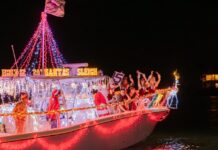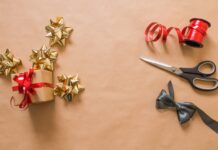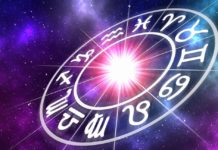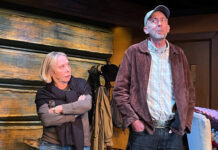Artist Lauren McAloon’s compositions manage to celebrate our similarities while critiquing contemporary politics and policies.
One of the most respected artists in Key West, McAloon’s solo exhibition, “Vessel Series: I’mmigration,” will show March 7-28 at The Studios of Key West, where McAloon worked for 16 years as facilities director, installing hundreds of exhibitions. She retired last year to focus on her own work and moved to a larger studio on Stock Island. The results speak for themselves.
The longtime sculptor is known for her exquisitely balanced compositions using found materials, wood, metal and ceramics, states The Studios’ website. “Her abstracted shapes of boats are a recurring theme, evoking both the near universality of immigration stories in all of our backgrounds and a scorching critique of the historic and contemporary politics” that have prompted dangerous ocean crossings in desperate pursuit of a different life.
The following is excerpted from Mark Hedden’s November 2022 profile of Lauren McAloon in Keys Weekly’s Home & Garden magazine.
ARTIST LAUREN MCALOON — THROUGH SPACE & TIME
Modern. Ancient. Timeless. Boats.
By Mark Hedden
Lauren McAloon’s studio is a proper, busy artist’s space, stuffed with spools of wire, wooden hoops, pipe organ pedals, royal palm fronds, washed up pieces of coral, iron bed frames, ladders, colored glass balls, tree stumps, cigar boxes, barbed wire, string, fan chain pulls, scrap wood, a lone pink ballet slipper, still in its wrapping. What doesn’t fit on a shelf or table gets hung on the wall. There are typically eight or 10 works in progress.
Boats and their parts have long been the predominant theme in McAloon’s work. Often her pieces will be a single vessel, usually elongated and narrow, usually combined with sheafs or loops of wire suspending the boats’ hulls over an invisible sea. Her work tends to look simultaneously modern, ancient and timeless.



“I find the shape really sexy. Boat shapes, especially working boats, have references to travel and voyages and history. A lot of my work has a historical base to it. Immigration and migration — by choice or not — really pulls at me.”
“For me, it’s important that my pieces are visually strong. But there’s also layers and layers of meaning — to me — to most of the pieces,” said McAloon.
“I was actually having a drink at a bar in town, and a bunch of people were talking about migrants and stuff like that. A guy started asking me, ‘What’s with the boats, Lauren?’ And I said, ‘OK, everyone here, how did your family get to the U.S.? And it was, well my uncle came – or my great grandfather came – on a boat from Italy. By boat from Poland. By boat from… by boat from… by boat from…”
Unless you’re an American Indian or you and/or your family migrated more recently, your people most likely came by boat, McAloon noted.
“A lot of people, their history is rooted in someone making a decision to step onto – or being forced to step onto – a boat. To me that’s such a common thread. It’s amazing. Amazing,” she said.
McAloon and her late husband Brendan arrived in Key West by car on Christmas Eve in 1990, she thinks. It could have been 1991. The plan was to work in Key West for a few months to earn enough money to head south to the islands.
They made it to Full Moon Saloon that first night, spent a week at the hostel for $13 a night, then spent 30 years in the apartment they rented after that first week.
(Brendan passed away in 2016.)
She ended up running the fish department at the former Waterfront Market for 13 years, a job, she said, that actually prepared her for work at The Studios of Key West.
“You had to really display things well for people to see, but it also had to do with texture and color,” McAloon said. “It was the same as putting up exhibitions. You get 120 pieces by 120 different artists, and you want to make it so things relate to each other, whether it’s color or subject matter.”
The piece that changed her trajectory was a weathervane — the silhouette of a dancing woman trailed by stars — that she’d created while taking a welding class at Florida Keys Community College (now the College of the Florida Keys). It ended up in Sculpture Key West, an outdoor art show that used to fill Fort Zachary Taylor with sculptures for a few weeks a year. McAloon became one of the stalwarts of the then-annual event.
A few years later, her Sculpture Key West installation, “Threshold,” included 48 aeolian flutes – one for each year (at the time) of the United States’ Cuban embargo.
There were also a series of steel and iron rudders, salvaged from Cuban chugs, rising up out of the water onto the beach. It’s a work that people who saw it at the time still think about.

























